Dynamic Evolution of Aquaculture along the Bohai Sea Coastline and Implications for Eco-Coastal Vegetation Restoration Based on Remote Sensing
Abstract
1. Introduction
2. Study Area
3. Results
3.1. Spatiotemporal Cover Changes in Aquaculture Ponds over the Past 38 Years
3.2. Changes in Aquaculture Area in Different Provinces
3.3. Spatiotemporal Changes in Centroids of Aquaculture Ponds over the Past 38 Years
3.4. The Impact of Aquaculture Expansion on the Bohai Sea Coastline
3.5. The Impact of Coastline Expansion on Average NDVI Values in Coastal Zones
4. Discussions
5. Data and Methods
5.1. Data
5.2. Extracting Aquaculture Ponds’ Cover Data
5.3. Measuring the Dynamic Changes in Aquaculture Ponds
5.4. Measuring the Impact of Aquaculture Expansion on the Coastline
5.5. Accuracy Assessment
6. Conclusions
- (1)
- The aquaculture area showed a trend of increasing from 1984 to 2022, with an increase of 538%. Spatially, aquaculture was mainly distributed in Hebei Province and Tianjin City, in 1984, but was distributed in Hebei Province, Tianjin City, Liaoning Province, and Shandong Province in 2022
- (2)
- The area change trends in different provinces and cities were different. The aquaculture area of Shandong Province and Liaoning Province increased year by year from 1984 to 2022, while the aquaculture area of Hebei Province and Tianjin City showed an overall “increase–decrease” trend from 1984 to 2022.
- (3)
- The spatio-temporal changes in aquaculture’s centroids varied among different provinces and cities.
- (4)
- The expansion of aquaculture ponds decreased the coastal NDVI, with the pond area increasing from 0 km2 to 46 km2 and the NDVI decreasing from 0.41 to −0.21. However, the NDVI increased to 0.25 when the coastal ponds decreased to 0 km2.
- (5)
- The expansion of aquaculture of the Bohai Sea increased the length of the corresponding coastline, which grew by 449% from 1984 to 2022. It also caused the Bohai Sea coastline to advance towards the sea, with most of the coastline advancing at a speed of 0–100 m/a.
Supplementary Materials
Author Contributions
Funding
Data Availability Statement
Conflicts of Interest
References
- Primavera, J.H. Overcoming the impacts of aquaculture on the coastal zone. Ocean Coast. Manag. 2006, 49, 531–545. [Google Scholar] [CrossRef]
- Zhang, R.L.; Pei, J.Y.; Zhang, R.J.; Wang, S.P.; Zeng, W.B.; Huang, D.L.; Wang, Y.; Zhang, Y.Y.; Wang, Y.H.; Yu, K.F. Occurrence and distribution of antibiotics in mariculture farms, estuaries and the coast of the Beibu Gulf, China: Bioconcentration and diet safety of seafood. Ecotoxicol. Environ. Saf. 2018, 154, 27–35. [Google Scholar] [CrossRef] [PubMed]
- Renaud, F.G.; Syvitski, J.P.M.; Sebesvari, Z.; Werners, S.E.; Kremer, H.; Kuenzer, C.; Ramesh, R.; Jeuken, A.; Friedrich, J. Tipping from the Holocene to the Anthropocene: How threatened are major world deltas? Curr. Opin. Environ. Sustain. 2013, 5, 644–654. [Google Scholar] [CrossRef]
- The Food and Agriculture Organization of the United Nations. The State of World Fisheries and Aquaculture 2022. Available online: https://www.fao.org/fishery/en/publications/295133 (accessed on 5 April 2023).
- Jin, S.Y.; Kong, Q.L.; John, C.K.; Wang, Z.Y.; Zhang, T.L.; Li, X.Q.; Zhu, X.Y.; Li, J.; Luo, Y.; Qian, M.Y. Natural Biota’s Contribution to Cultured Aquatic Animals’ Growth in Aquaculture Cannot Be Ignored. Aquac. Res. 2023, 2023, 2646607. [Google Scholar] [CrossRef]
- Snow, A.; Anderson, B.; Wootton, B. Flow-through land-based aquaculture wastewater and its treatment in subsurface flow constructed wetlands. Environ. Rev. 2012, 20, 54–69. [Google Scholar] [CrossRef]
- Azra, M.N.; Okomoda, V.T.; Ikhwanuddin, M. Breeding Technology as a Tool for Sustainable Aquaculture Production and Ecosystem Services. Front. Environ. Sci. 2022, 9, 679529. [Google Scholar] [CrossRef]
- Mansour, A.T.; Ashour, M.; Alprol, A.E.; Alsaqufi, A.S. Aquatic Plants and Aquatic Animals in the Context of Sustainability: Cultivation Techniques, Integration, and Blue Revolution. Sustainability 2022, 14, 3527. [Google Scholar] [CrossRef]
- Sun, F.L.; Wang, C.Z.; Yang, H.Q. Physicochemical Factors Drive Bacterial Communities in an Aquaculture Environment. Front. Environ. Sci. 2021, 9, 9. [Google Scholar] [CrossRef]
- Wang, Q.D.; Mao, C.Z.; Lei, L.; Yan, B.; Yuan, J.; Guo, Y.Y.; Li, T.L.; Xiong, X.; Cao, X.Y.; Huang, J.; et al. Antibiotic resistance genes and their links with bacteria and environmental factors in three predominant freshwater aquaculture modes. Ecotoxicol. Environ. Saf. 2022, 241, 12. [Google Scholar] [CrossRef]
- Yang, P.; Lai, D.Y.F.; Jin, B.S.; Bastviken, D.; Tan, L.S.; Tong, C. Dynamics of dissolved nutrients in the aquaculture shrimp ponds of the Min River estuary, China: Concentrations, fluxes and environmental loads. Sci. Total Environ. 2017, 603, 256–267. [Google Scholar] [CrossRef]
- Virdis, S.G.P. An object-based image analysis approach for aquaculture ponds precise mapping and monitoring: A case study of Tam Giang-Cau Hai Lagoon, Vietnam. Environ. Monit. Assess. 2014, 186, 117–133. [Google Scholar] [CrossRef]
- Jin, K.; Jin, Y.S.; Wang, F.; Wang, S.X. Impacts of anthropogenic activities on vegetation cover changes in the Circum-Bohai-Sea region, China. Geocarto Int. 2022, 37, 9339–9354. [Google Scholar] [CrossRef]
- Wang, S.X.; Huang, C.; Li, H.; Liu, Q.S. Synergistic Integration of Time Series Optical and SAR Satellite Data for Mariculture Extraction. Remote Sens. 2023, 15, 2243. [Google Scholar] [CrossRef]
- Ministry of Agriculture and Rural Affairs of the People’s Republic of China. The Statistics Yearbook of China Fisheries and Aquaculture 2023. Available online: https://www.cafs.ac.cn/info/1397/37342.htm (accessed on 10 April 2023).
- Shandong Provincial Department of Agriculture and Rural Affairs. The Statistics Yearbook of Shandong Fisheries and Aquaculture 2022. Available online: http://nync.shandong.gov.cn/zwgk/nytj/2022n/ (accessed on 11 April 2023).
- Song, Y.; Li, G.; Wu, J.; Zhou, J.; Wang, Y. Spatial variation of aquaculture ponds in the Bohai Rim region during 1989–2019. Mar. Sci. Bull. 2021, 40, 92–100. [Google Scholar]
- Li, X.B.; Kang, Y.H.; Wang, X.M. Response of soil properties and vegetation to reclamation period using drip irrigation in coastal saline soils of the Bohai Gulf. Paddy Water Environ. 2019, 17, 803–812. [Google Scholar] [CrossRef]
- Sharp, S.L.; Forrest, A.L.; Bouma-Gregson, K.; Jin, Y.F.; Cortes, A.; Schladow, S.G. Quantifying Scales of Spatial Variability of Cyanobacteria in a Large, Eutrophic Lake Using Multiplatform Remote Sensing Tools. Front. Environ. Sci. 2021, 9, 19. [Google Scholar] [CrossRef]
- Zhen, Z.; Xu, N.; Li, Y.; Li, Y. Sub-continental-scale mapping of tidal wetland composition for East Asia: A novel algorithm integrating satellite tide-level and phenological features. Remote Sens. Environ. 2022, 269, 112799. [Google Scholar] [CrossRef]
- Zhang, H.; Hu, L.; Zhang, D.; Zhou, Y.; Ma, Y.; Wang, X.H.; Wang, Y.; Xu, M.; Xu, N. A Method to Derive Tidal Flat Topography in Nantong, China Using MODIS Data and Tidal Levels. Can. J. Remote Sens. 2021, 47, 17–32. [Google Scholar] [CrossRef]
- Liu, Z.J.; Xu, N.; Wang, J.Y. Satellite-Observed Evolution Dynamics of the Yellow River Delta in 1984–2018. IEEE J. Sel. Top. Appl. Earth Obs. Remote Sens. 2020, 13, 6044–6050. [Google Scholar] [CrossRef]
- Wang, K.F. Evolution of Yellow River Delta Coastline Based on Remote Sensing from 1976 to 2014, China. Chin. Geogr. Sci. 2019, 29, 181–191. [Google Scholar] [CrossRef]
- Liu, C.L.; Chang, J.; Chen, M.J.; Zhang, T. Dynamic Monitoring and Its Influencing Factors Analysis of Coastline in the Laizhou Bay since 1985. J. Coast. Res. 2020, 105, 18–22. [Google Scholar] [CrossRef]
- Chen, Y.; Dong, J.; Xiao, X.; Ma, Z.; Tan, K.; Melville, D.; Li, B.; Lu, H.; Liu, J.; Liu, F. Effects of reclamation and natural changes on coastal wetlands bordering China’s Yellow Sea from 1984 to 2015. Land Degrad. Dev. 2019, 30, 1533–1544. [Google Scholar] [CrossRef]
- Xiao, S.J.; Yi, L.; Wang, Z.J.; Liu, H.Y.; Gao, H.; Yu, Z.Y. Remote Sensing Image-Based Comprehensive Monitoring Detection Platform for Coastal Tidal Mudflat Ecological Development. Front. Environ. Sci. 2022, 10, 12. [Google Scholar] [CrossRef]
- Wang, Y.X.; He, X.Q.; Bai, Y.; Tan, Y.Y.; Zhu, B.Z.; Wang, D.F.; Ou, M.Y.; Gong, F.; Zhu, Q.K.; Huang, H.Q. Automatic detection of suspected sewage discharge from coastal outfalls based on Sentinel-2 imagery. Sci. Total Environ. 2022, 853, 12. [Google Scholar] [CrossRef]
- Zhu, X.T.; Guo, H.W.; Huang, J.J.; Tian, S.; Xu, W.; Mai, Y.Q. An ensemble machine learning model for water quality estimation in coastal area based on remote sensing imagery. J. Environ. Manag. 2022, 323, 12. [Google Scholar] [CrossRef]
- Zhang, R.; Chen, Y.; Chen, P.; Zhou, X.; Wu, B.; Chen, K.; Sun, Z.; Yao, P. Impacts of tidal flat reclamation on suspended sediment dynamics in the tidal-dominated Wenzhou Coast, China. Front. Mar. Sci. 2023, 10, 1097177. [Google Scholar] [CrossRef]
- Richards, D.R.; Friess, D.A. Rates and drivers of mangrove deforestation in Southeast Asia, 2000–2012. Proc. Natl. Acad. Sci. USA 2016, 113, 344–349. [Google Scholar] [CrossRef]
- Veettil, B.K.; Quang, N.X.; Trang, N.T.T. Changes in mangrove vegetation, aquaculture and paddy cultivation in the Mekong Delta: A study from Ben Tre Province, southern Vietnam. Estuar. Coast. Shelf Sci. 2019, 226, 8. [Google Scholar] [CrossRef]
- Peng, Y.; Sengupta, D.; Duan, Y.Q.; Chen, C.P.; Tian, B. Accurate mapping of Chinese coastal aquaculture ponds using biophysical parameters based on Sentinel-2 time series images. Mar. Pollut. Bull. 2022, 181, 14. [Google Scholar] [CrossRef]
- Zou, Z.H.; Chen, C.; Liu, Z.S.; Zhang, Z.L.; Liang, J.T.; Chen, H.X.; Wang, L.Y. Extraction of Aquaculture Ponds along Coastal Region Using U-2-Net Deep Learning Model from Remote Sensing Images. Remote Sens. 2022, 14, 4001. [Google Scholar] [CrossRef]
- Zeng, Z.; Wang, D.; Tan, W.X.; Yu, G.L.; You, J.C.; Lv, B.T.; Wu, Z.H. RCSANet: A Full Convolutional Network for Extracting Inland Aquaculture Ponds from High-Spatial-Resolution Images. Remote Sens. 2021, 13, 92. [Google Scholar] [CrossRef]
- Luo, J.H.; Sun, Z.; Lu, L.R.; Xiong, Z.Y.; Cui, L.P.; Mao, Z.G. Rapid expansion of coastal aquaculture ponds in Southeast Asia: Patterns, drivers and impacts. J. Environ. Manag. 2022, 315, 10. [Google Scholar] [CrossRef] [PubMed]
- Tew, Y.L.; Tan, M.L.; Samat, N.; Chan, N.W.; Mahamud, M.A.; Sabjan, M.A.; Lee, L.K.; See, K.F.; Wee, S.T. Comparison of Three Water Indices for Tropical Aquaculture Ponds Extraction using Google Earth Engine. Sains Malays. 2022, 51, 369–378. [Google Scholar] [CrossRef]
- Xia, Z.L.; Guo, X.N.; Chen, R.S. Automatic extraction of aquaculture ponds based on Google Earth Engine. Ocean Coast. Manag. 2020, 198, 10. [Google Scholar] [CrossRef]
- Duan, Y.Q.; Tian, B.; Li, X.; Liu, D.Y.; Sengupta, D.; Wang, Y.J.; Peng, Y. Tracking changes in aquaculture ponds on the China coast using 30 years of Landsat images. Int. J. Appl. Earth Obs. Geoinf. 2021, 102, 11. [Google Scholar] [CrossRef]
- Ren, C.Y.; Wang, Z.M.; Zhang, Y.Z.; Zhang, B.; Chen, L.; Xi, Y.B.; Xiao, X.M.; Doughty, R.B.; Liu, M.Y.; Jia, M.M.; et al. Rapid expansion of coastal aquaculture ponds in China from Landsat observations during 1984–2016. Int. J. Appl. Earth Obs. Geoinf. 2019, 82, 101902. [Google Scholar] [CrossRef]
- Zhu, L.H.; Hu, R.J.; Zhu, H.J.; Jiang, S.H.; Xu, Y.C.; Wang, N. Modeling studies of tidal dynamics and the associated responses to coastline changes in the Bohai Sea, China. Ocean Dyn. 2018, 68, 1625–1648. [Google Scholar] [CrossRef]
- Wang, Z.; Zhang, J.; Yang, X. Global mapping of the landside clustering of aquaculture ponds from dense time-series 10 m Sentinel-2 images on Google Earth Engine. Int. J. Appl. Earth Obs. Geoinf. 2022, 115, 103100. [Google Scholar] [CrossRef]
- Guo, P.R.; Wu, L.L.; Wang, Y.; Liu, D.; Li, J.A. Effects of Drought Stress on the Morphological Structure and Flower Organ Physiological Characteristics of Camellia oleifera Flower Buds. Ocean Dyn. 2018, 68, 2585. [Google Scholar] [CrossRef]
- Huang, Z.; Xu, H.J.; Bai, Y.C.; Shi, F.S.; Wen, Z.C. Coastline changes and tidal current responses due to the large-scale reclamations in the Bohai Bay. J. Oceanol. Limnol. 2023. Early Access. [Google Scholar] [CrossRef]
- Van Wesenbeeck, B.K.; Balke, T.; Van Eijk, P.; Tonneijck, F.; Siry, H.Y. Aquaculture induced erosion of tropical coastlines throws coastal communities back into poverty. Ocean. Coast. Manag. 2015, 116, 466–469. [Google Scholar] [CrossRef]
- Duan, Y.Q.; Li, X.; Zhang, L.P.; Liu, W.; Liu, S.A.; Chen, D.; Ji, H.Y. Detecting spatiotemporal changes of large-scale aquaculture ponds regions over 1988-2018 in Jiangsu Province, China using Google Earth Engine. Ocean Coast. Manag. 2020, 188, 11. [Google Scholar] [CrossRef]
- Ozturk, D.; Sesli, F.A. Shoreline change analysis of the Kizilirmak Lagoon Series. Ocean Coast. Manag. 2015, 118, 290–308. [Google Scholar] [CrossRef]
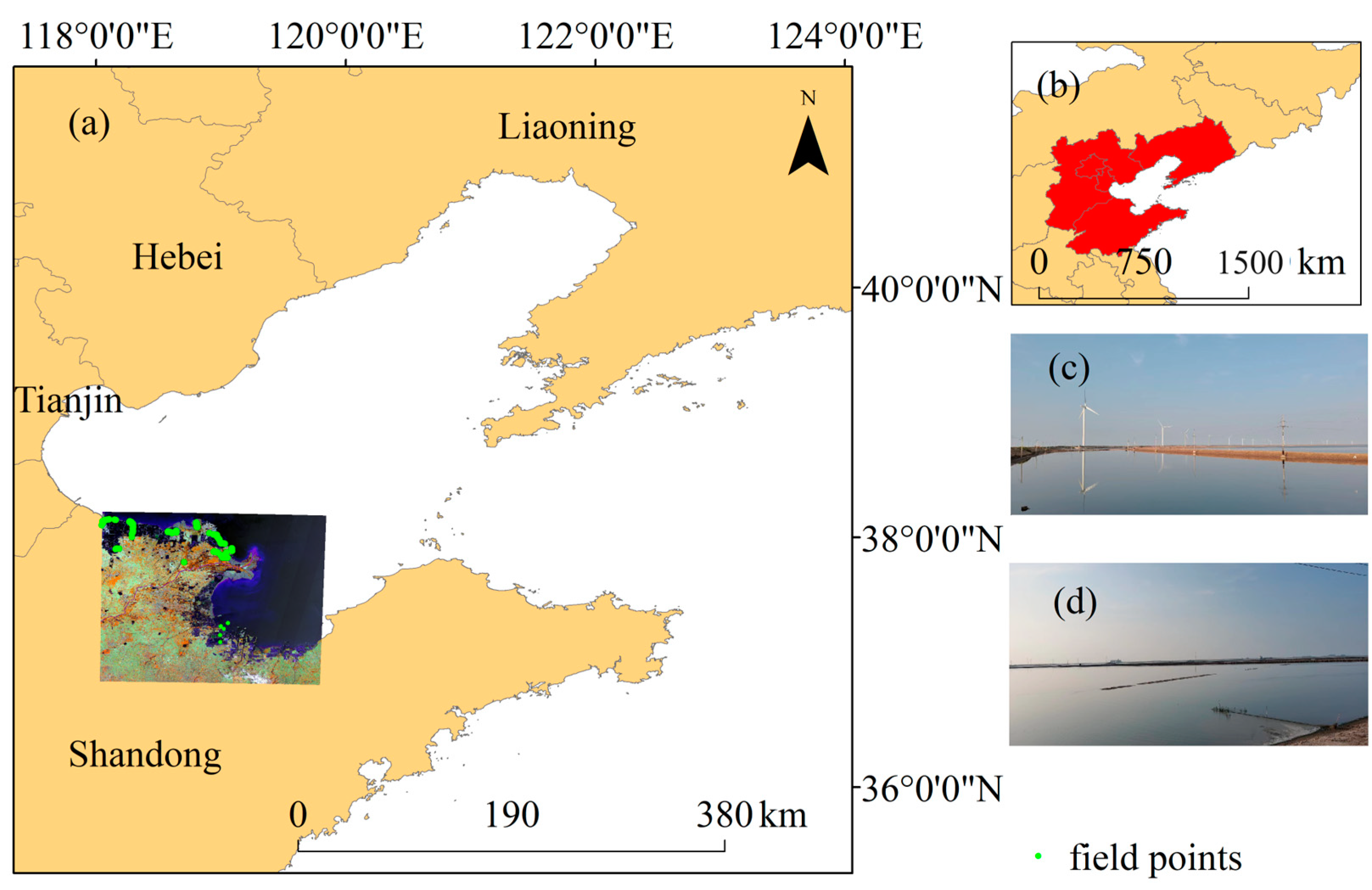
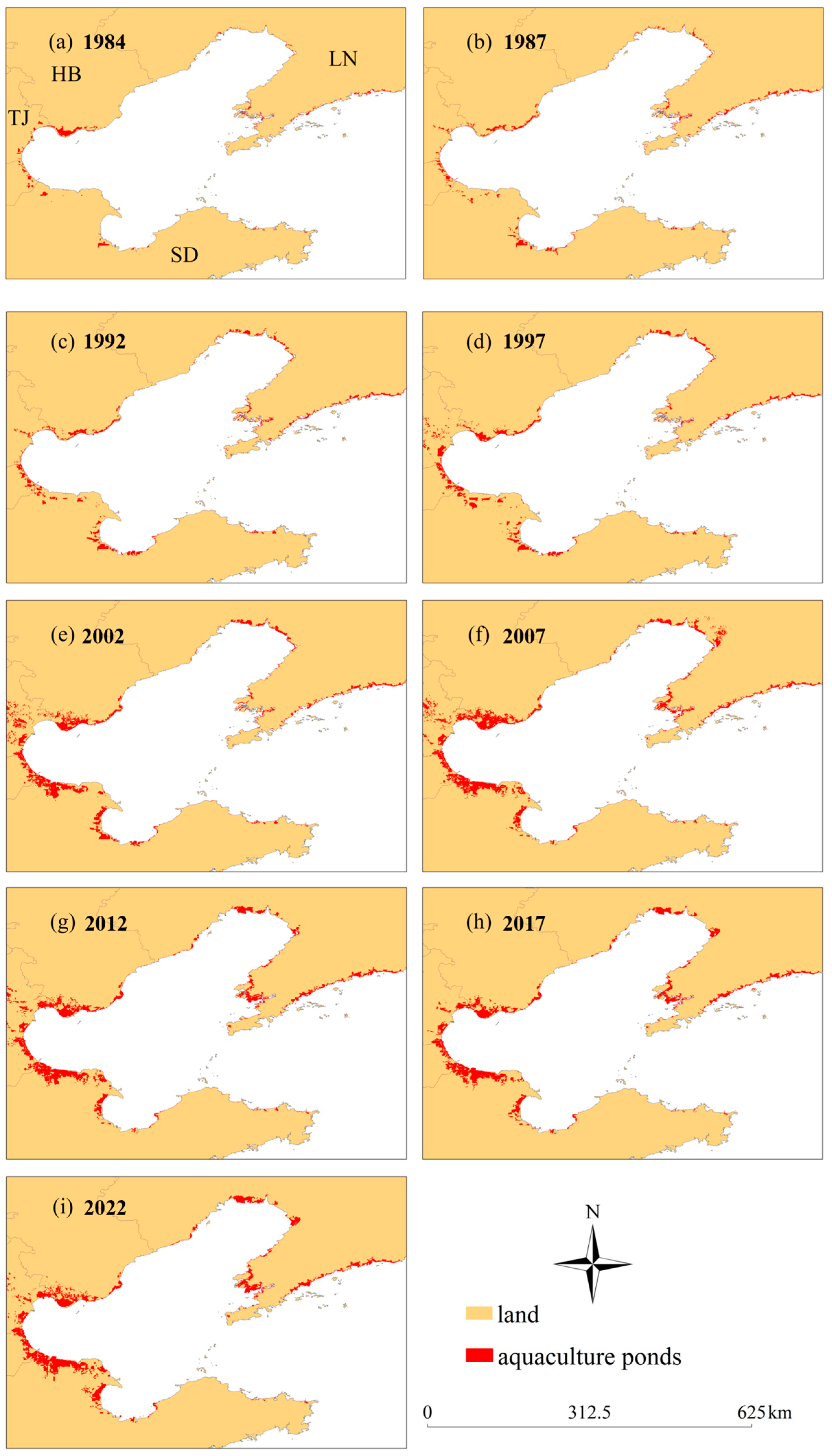
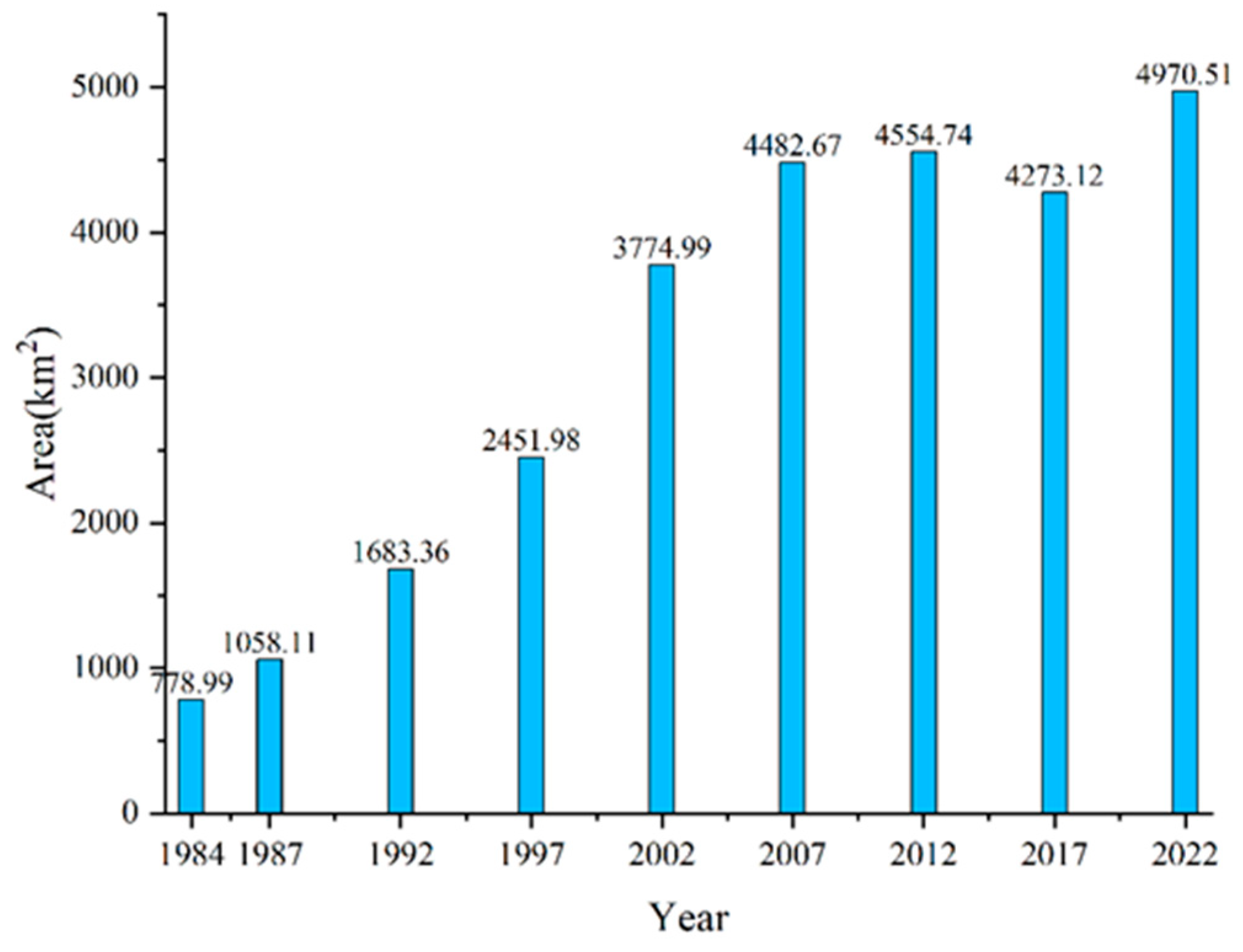
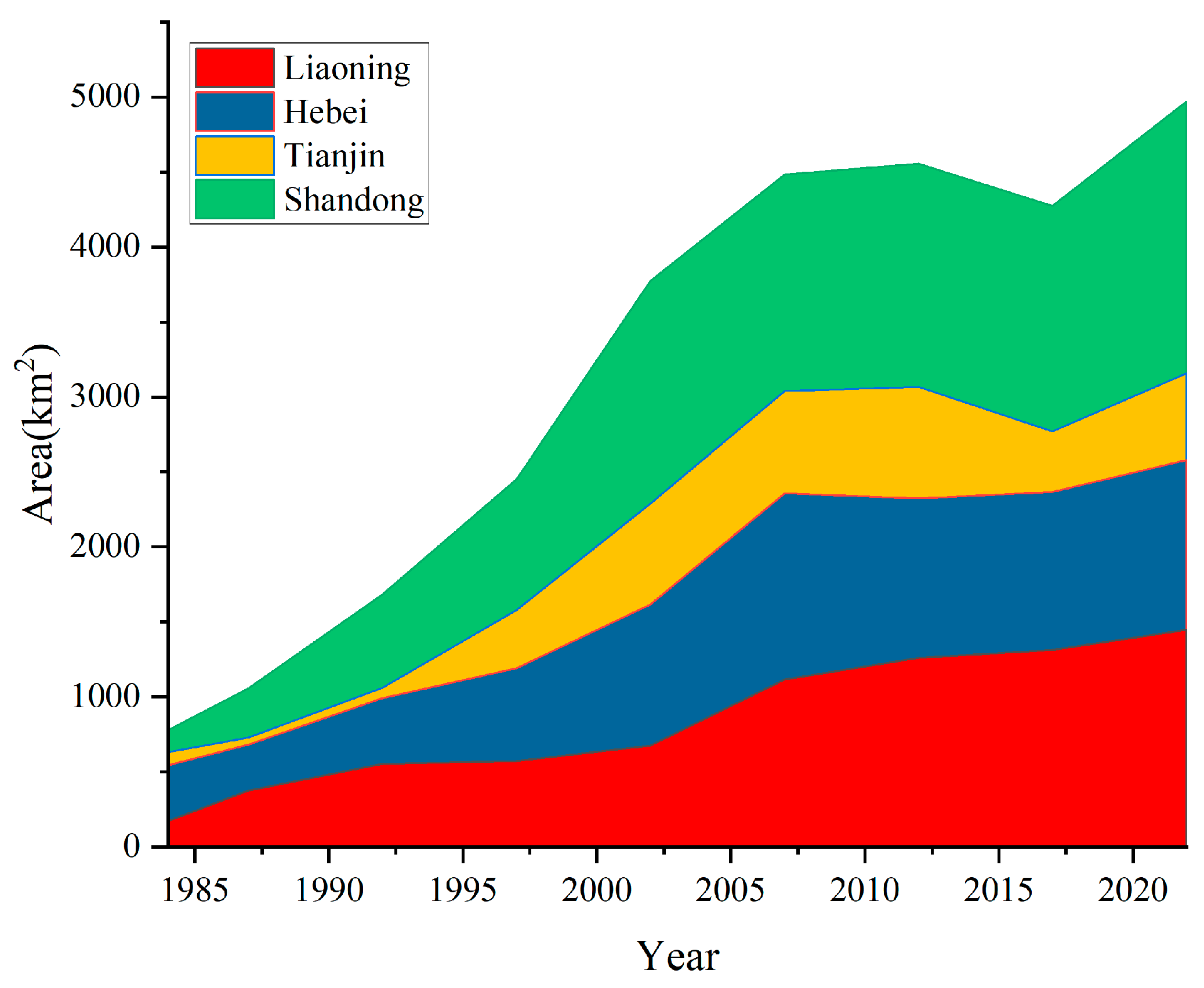
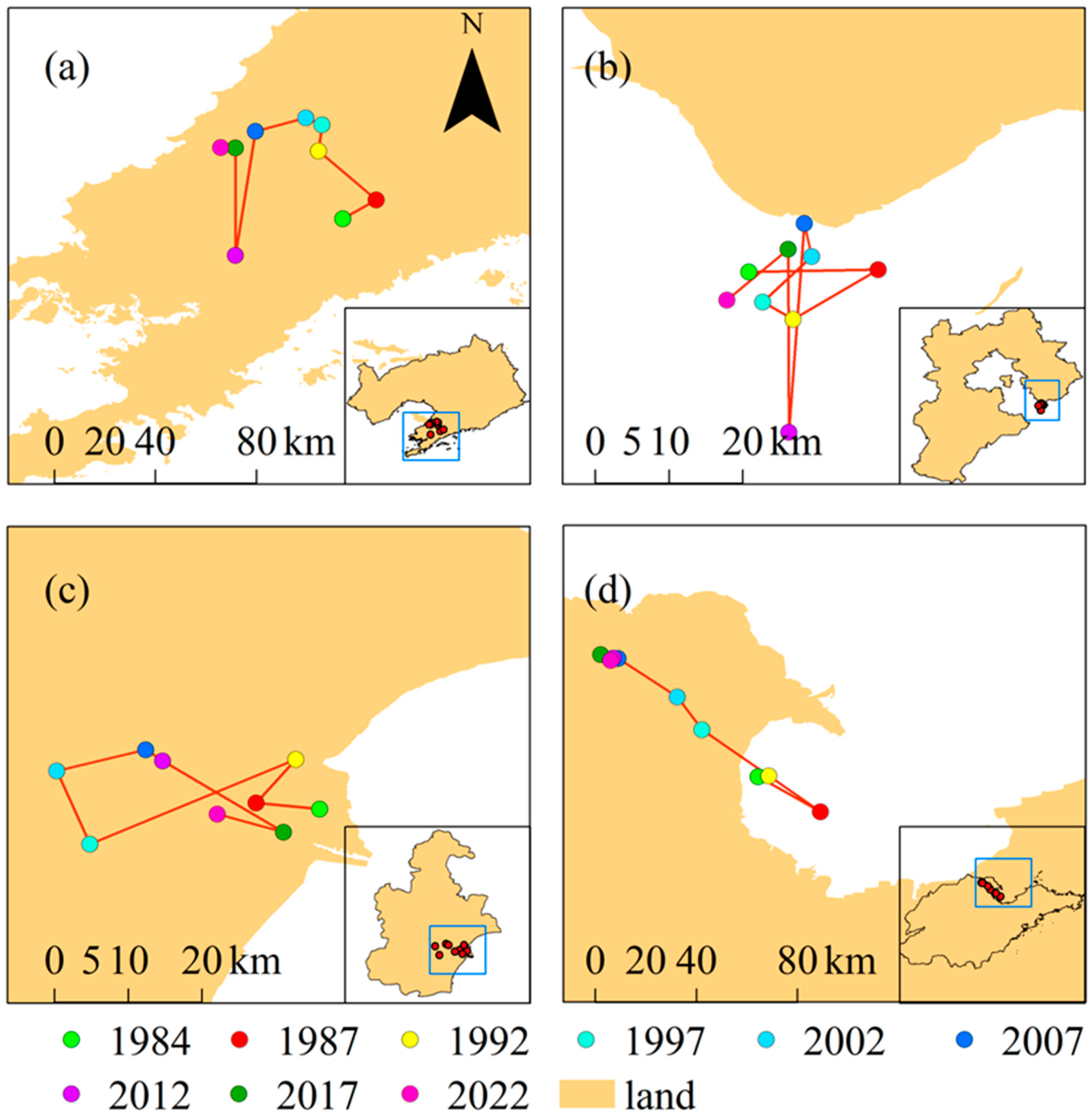
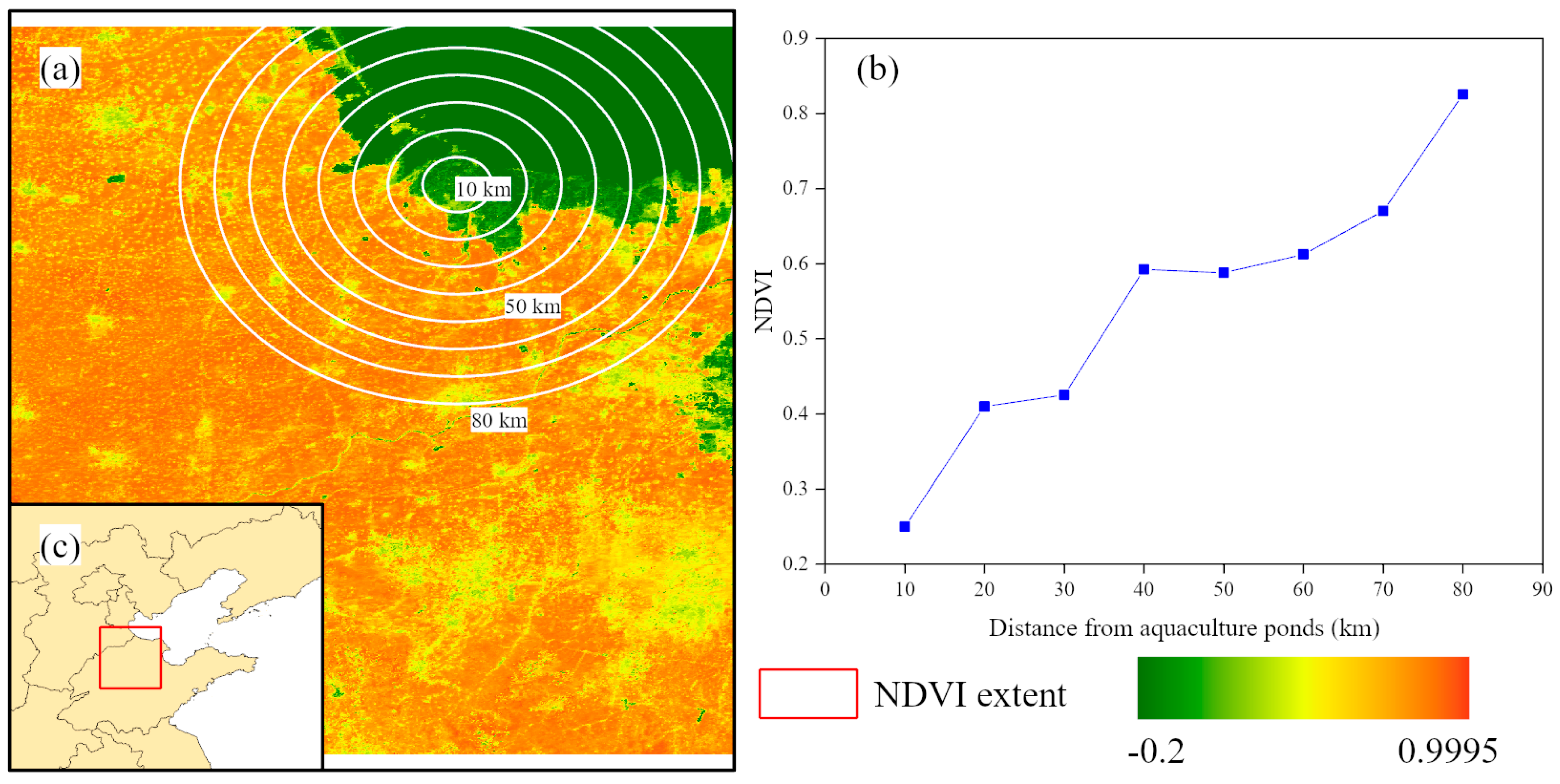
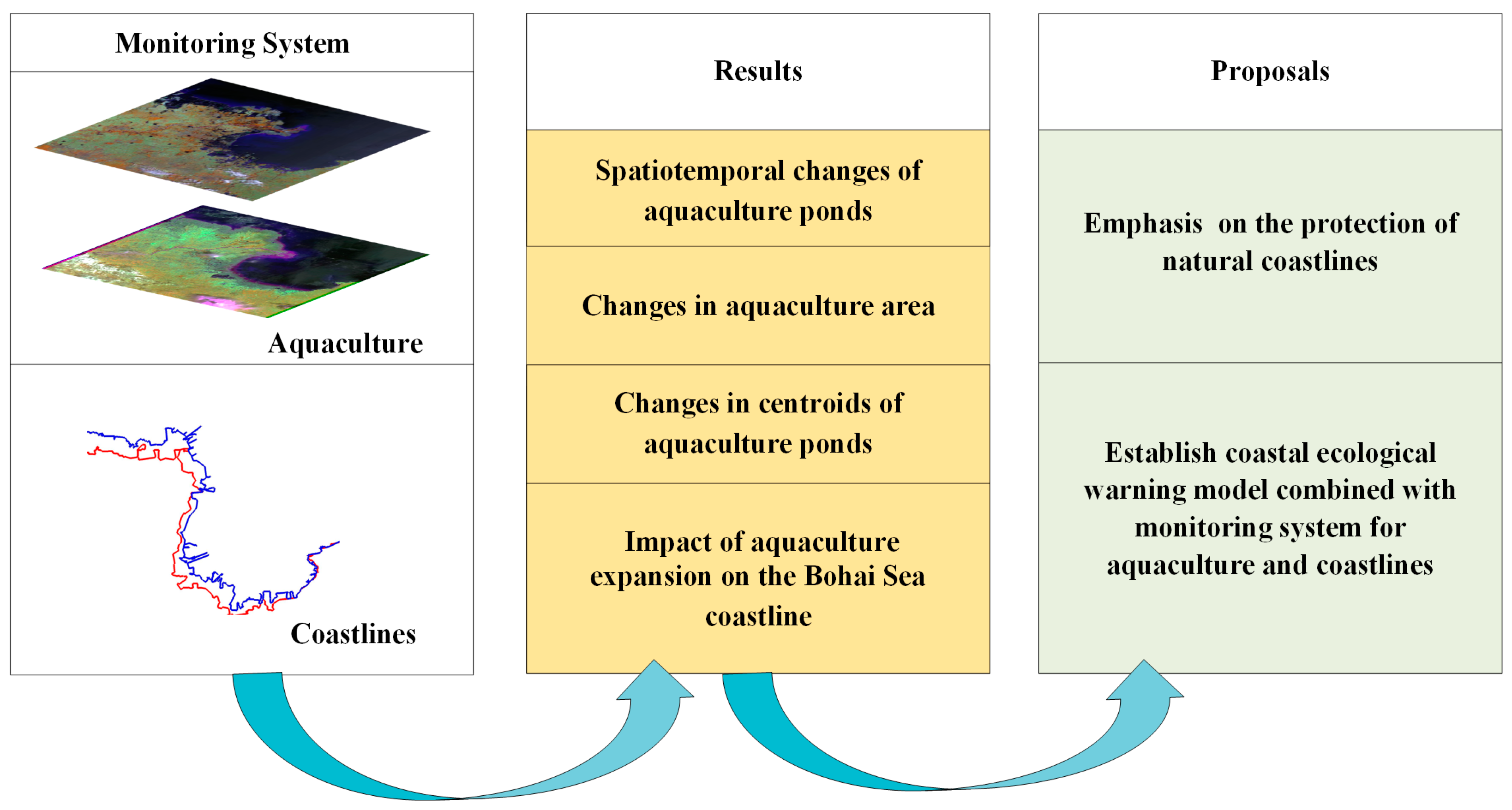
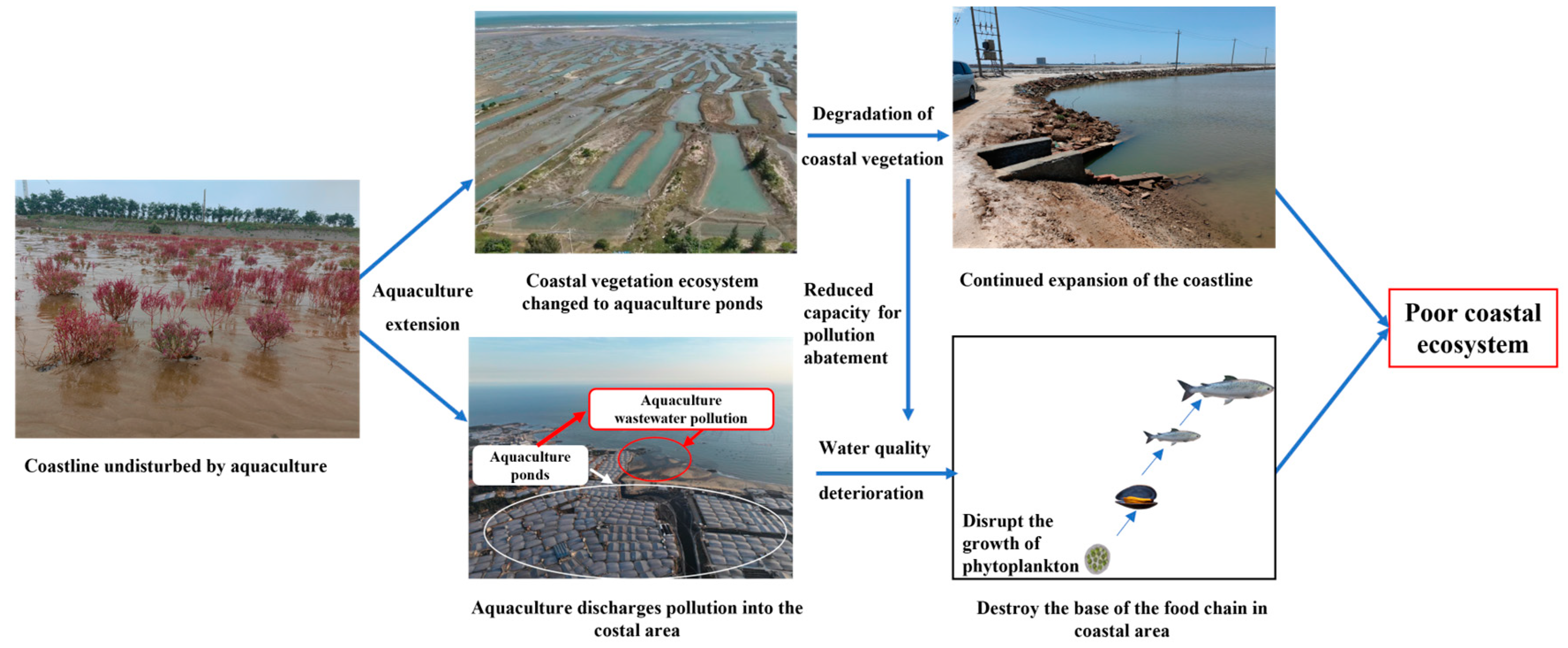
| 1984–1987 | 1987–1992 | 1992–1997 | 1997–2002 | |
|---|---|---|---|---|
| Liaoning | 13 km | 26 km | 10 km | 6 km |
| Hebei | 14 km | 11 km | 4 km | 8 km |
| Tianjin | 7 km | 7 km | 25 km | 10 km |
| Shandong | 24 km | 22 km | 28 km | 15 km |
| 2002–2007 | 2007–2012 | 2012–2017 | 2017–2022 | |
|---|---|---|---|---|
| Liaoning | 16 km | 49 km | 42 km | 4 km |
| Hebei | 5 km | 28 km | 25 km | 9 km |
| Tianjin | 10 km | 2 km | 16 km | 7 km |
| Shandong | 24 km | 1 km | 4 km | 4 km |
| 1984 | 2022 | |
|---|---|---|
| Liaoning | 219 km | 1205 km |
| Hebei | 104 km | 226 km |
| Tianjin | 36 km | 51 km |
| Shandong | 79 km | 356 km |
| 0–100 (m/y) | 100–200 (m/y) | 200–300 (m/y) | 300–400 (m/y) | 400–500 (m/y) | 500–600 (m/y) | 600–700 (m/y) | |
|---|---|---|---|---|---|---|---|
| Liaoning | 322 km | 76 km | 58 km | 0 km | 0 km | 0 km | 0 km |
| Hebei | 139 km | 32 km | 0 km | 13 km | 0 km | 0 km | 0 km |
| Tianjin | 44 km | 2 km | 0 km | 0 km | 0 km | 0 km | 0 km |
| Shandong | 102 km | 37 km | 69 km | 32 km | 0 km | 0 km | 15 km |
| 1984 | 2012 | 2022 | |
|---|---|---|---|
| NDVI | 0.48 | −0.21 | 0.25 |
| Coastline | 78 km | 283 km | 356 km |
| Area | 0 km2 | 45 km2 | 0 km2 |
Disclaimer/Publisher’s Note: The statements, opinions and data contained in all publications are solely those of the individual author(s) and contributor(s) and not of MDPI and/or the editor(s). MDPI and/or the editor(s) disclaim responsibility for any injury to people or property resulting from any ideas, methods, instructions or products referred to in the content. |
© 2024 by the authors. Licensee MDPI, Basel, Switzerland. This article is an open access article distributed under the terms and conditions of the Creative Commons Attribution (CC BY) license (https://creativecommons.org/licenses/by/4.0/).
Share and Cite
Wang, Z.; Liu, K. Dynamic Evolution of Aquaculture along the Bohai Sea Coastline and Implications for Eco-Coastal Vegetation Restoration Based on Remote Sensing. Plants 2024, 13, 160. https://doi.org/10.3390/plants13020160
Wang Z, Liu K. Dynamic Evolution of Aquaculture along the Bohai Sea Coastline and Implications for Eco-Coastal Vegetation Restoration Based on Remote Sensing. Plants. 2024; 13(2):160. https://doi.org/10.3390/plants13020160
Chicago/Turabian StyleWang, Zhaohua, and Kai Liu. 2024. "Dynamic Evolution of Aquaculture along the Bohai Sea Coastline and Implications for Eco-Coastal Vegetation Restoration Based on Remote Sensing" Plants 13, no. 2: 160. https://doi.org/10.3390/plants13020160
APA StyleWang, Z., & Liu, K. (2024). Dynamic Evolution of Aquaculture along the Bohai Sea Coastline and Implications for Eco-Coastal Vegetation Restoration Based on Remote Sensing. Plants, 13(2), 160. https://doi.org/10.3390/plants13020160






